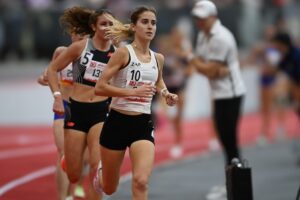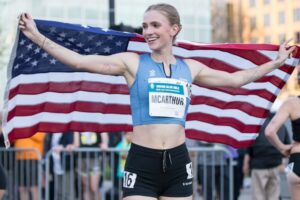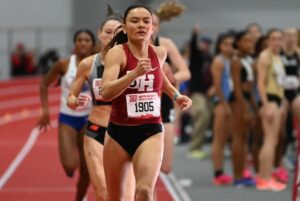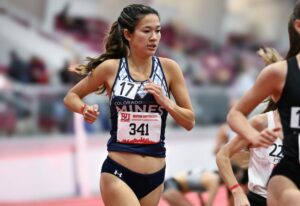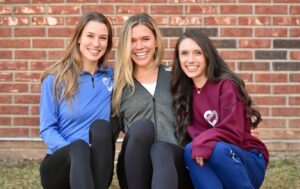
Last summer, Gracie Hyde, 24, was done with collegiate running. Struggling with an eating disorder and her mental health, she and her doctors decided it was best that she forgo her remaining eligibility and medically retire from competing in the NCAA. That meant she would stay at the University of Arkansas, complete her masters degree, and keep her scholarship, but she would no longer be a part of the school’s cross country and track & field teams.
Sometimes plans change, however, and less than a year later, she’s a five-time Division II national champion for Adams State, and she holds DII records in the indoor 3,000m (8:58.33), DMR (11:08.94), 1500m (4:08.95), and steeplechase (9:28.17). She also has the fastest mile time ever by a DII runner (4:30.90 indoors, which doesn’t count as a record because it was on an oversized track).
Hyde started off her college career with two years at the University of Central Arkansas, before spending three years at Arkansas. (She had a sixth year of eligibility because all college athletes were granted an extra year due to the pandemic.) Initially, she improved quickly and had a lot of positive experiences at both schools. But that gradually began to change.
“In the sport of running, people talk about women’s bodies and the way they look,” Hyde told Fast Women. “Upon coming to college and comparing myself to other runners, I started picking up some pretty unhealthy habits on my own.”
Her eating disorder became particularly bad while she was at Arkansas, but she doesn’t blame anyone there for causing it. By January 2023, she couldn’t take it anymore. She confided in one of Arkansas’ athletic trainers. “I told him all of the unhealthy, terrible things I had been doing to my body,” she said. “It was a really emotional time, but I finally broke down and asked for the help I knew I had been needing for so long.”
Hyde gives tremendous credit to the athletic training staff at Arkansas for doing “absolutely everything they could possibly think of to help me,” she said. “They were wonderful.”
She struggled through her final season at Arkansas. Although she finished second in the steeplechase and seventh in the 5,000m at the SEC Championships, in what was her last race for Arkansas, Hyde placed 48th out of 48 runners in the steeplechase at the West Regional, running nearly a minute slower than her best time.
“When you’re not fueling, you can’t finish workouts,” she said. “When you can’t finish workouts, that’s really frustrating for you, and it’s frustrating for your coach, especially because I wasn’t super open with him about the struggles I was having. So it made it difficult for us to get along or make adjustments based on that. I dreaded going to practice. I had huge fears of going to starting lines. I would always get really panicky and sometimes even cry before the start of races. It just wasn’t enjoyable to me anymore.”
After her last race, Hyde took about three months entirely off from running. She did a short stint at an inpatient eating disorder treatment facility, but it wasn’t a good fit. When she left the facility, she had even more resolve to get better. And she thought she could stay healthy if she left behind the Arkansas program and collegiate competition.
“Once I stepped away, a ton of pressure was lifted off of me,” she said. “It wasn’t like I was trying to get fit or get back to a place I had been in 2021; I wasn’t trying to get back that fitness. The pressure of needing to earn my scholarship or be a leader was immediately lifted.”
Once she was in a better place, Hyde started going for short runs to test out whether she could participate in the sport in a healthy way. To her surprise, she was able to find joy in it, without the pressure.

Last September, a friend of Hyde’s took a job as the sprints coach at Adams State University in Alamosa, Colorado. Hyde helped him move there, and it piqued her interest in the school. She was impressed by how Alamosa was a big running town. Her friend told her that if she was going to run anyway, maybe she should consider running for Adams State.
She entered the transfer portal and met with head coach Damon Martin in September. She would have understood if he didn’t want to work with an athlete who was recovering from an eating disorder. “I remember him telling me that he didn’t care if I ran 5:00 in the mile or 4:30 in the mile, that he just wanted me to find my love for it again and he would love to be a part of it,” Hyde said.
The transition to training at 7,500 feet above sea level wasn’t easy. She moved to Alamosa on October 1, began training with some local alums, and enrolled at Adams State in January. At first, she says, she was hanging on for dear life during workouts. And she had some reservations about returning to competition.
“I was nervous to reintroduce that part of my life,” she said. “But instead of the bad habits returning, I feel like coach, the team, and the environment here pushed me the other way and it continued my recovery.”
Once she started competing, the results came quickly. She set the DII 3,000m record in February and ran the 4:30 mile two weeks later. At the NCAA DII Indoor Track & Field Championships, Hyde won the mile, 3,000m, and was part of the winning distance medley relay. And after being part of two national championship winning teams indoors at Arkansas, she helped Adams State win an indoor title as well.
Hyde was running much faster than she ever had. Outdoors, the improvement continued. She lowered her 1500m time from 4:19.20 at Arkansas to 4:08.95. And her steeplechase time dropped from 9:57.88 to 9:28.17. At the recent NCAA DII Outdoor Track & Field Championships, she added national titles in the steeplechase and the 1500.
The move to Division II had taken some of the performance pressure off. And while Adams State doesn’t have the resources that the University of Arkansas did—few schools do—Hyde says those things aren’t necessary to run fast. “For me, personally, happiness and health have been more important than any other resources that could be provided,” she said.
And the coaching has been top notch. “I think the way [Coach Martin] believes in me and instills a lot of confidence and belief in me has been a huge, huge upside compared to any coaching I’ve ever had,” she said. He also makes sure she’s keeping it fun. The last part of her race plans from him is always: Have fun.
Until this year, Hyde never thought running professionally was in the cards for her, but thanks to her fantastic bonus year in the NCAA, she’s now looking at several pro teams. As she talks to coaches, she has been candid about her past struggles and the fact that while she’s in a great place now, she needs to be in an environment where that will continue. “That’s the biggest thing I’m looking for when I’m looking at groups,” she said. “Who is going to help me make my happiness and health be the first priority?”
There’s room for growth in Hyde’s training. Her mileage has always been on the lower side. As a high schooler in Arkansas, she thinks she ran 10–15 miles per week at most. Now she runs about 50 miles per week. Wherever she goes, she plans to finish her MBA in sports leadership at Adams State remotely.
She will continue racing this summer and will run the steeplechase at the U.S. Olympic Track & Field Trials later this month. She’s looking for more than just racking up experience. “Going into the Trials, the intent is to make the team,” she said. “I think that I have to bet on myself in order to do that, so I’m going to keep saying it and hope it happens.”
At the same time, Hyde is reminding herself to appreciate the ride she’s on, which she never could have imagined one year ago.

